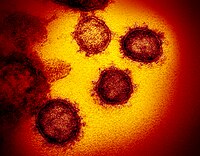
Photo from wikipedia
A novel coronavirus (SARS-CoV-2) has devastated the globe as a pandemic that has killed millions of people. Widespread vaccination is still uncertain, so many scientific efforts have been directed toward… Click to show full abstract
A novel coronavirus (SARS-CoV-2) has devastated the globe as a pandemic that has killed millions of people. Widespread vaccination is still uncertain, so many scientific efforts have been directed toward discovering antiviral treatments. Many drugs are being investigated to inhibit the coronavirus main protease, 3CLpro, from cleaving its viral polyprotein, but few publications have addressed this protease’s interactions with the host proteome or their probable contribution to virulence. Too few host protein cleavages have been experimentally verified to fully understand 3CLpro’s global effects on relevant cellular pathways and tissues. Here, I set out to determine this protease’s targets and corresponding potential drug targets. Using a neural network trained on cleavages from 392 coronavirus proteomes with a Matthews correlation coefficient of 0.985, I predict that a large proportion of the human proteome is vulnerable to 3CLpro, with 4,898 out of approximately 20,000 human proteins containing at least one putative cleavage site. These cleavages are nonrandomly distributed and are enriched in the epithelium along the respiratory tract, brain, testis, plasma, and immune tissues and depleted in olfactory and gustatory receptors despite the prevalence of anosmia and ageusia in COVID-19 patients. Affected cellular pathways include cytoskeleton/motor/cell adhesion proteins, nuclear condensation and other epigenetics, host transcription and RNAi, ribosomal stoichiometry and nascent-chain detection and degradation, ubiquitination, pattern recognition receptors, coagulation, lipoproteins, redox, and apoptosis. This whole proteome cleavage prediction demonstrates the importance of 3CLpro in expected and nontrivial pathways affecting virulence, lead me to propose more than a dozen potential therapeutic targets against coronaviruses, and should therefore be applied to all viral proteases and subsequently experimentally verified.
Journal Title: Computational Biology and Chemistry
Year Published: 2022
Link to full text (if available)
Share on Social Media: Sign Up to like & get
recommendations!